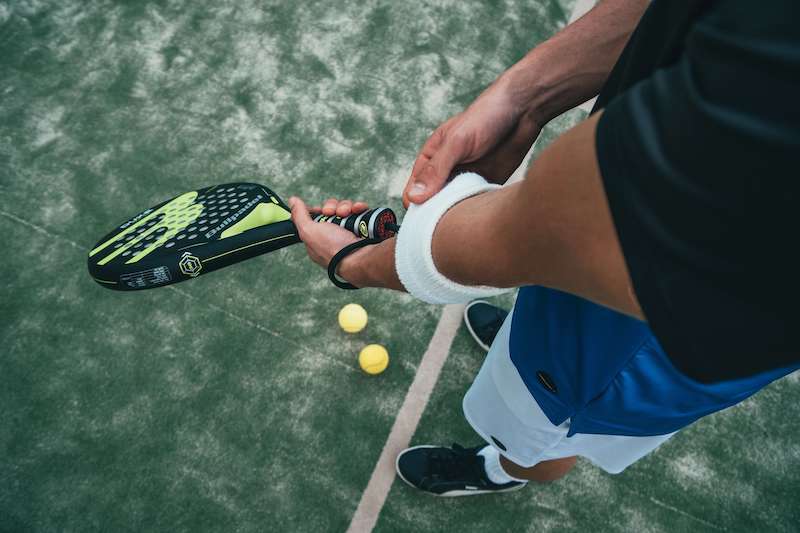Georgios Panagopoulos MD | Orthopaedic Surgeon

Η επικονδυλίτιδα είναι μια πάθηση που προκαλεί πόνο και φλεγμονή στους τένοντες που ξεκινούν από τον αγκώνα και συμβάλλουν στην κίνηση του καρπού και των δακτύλων. Διακρίνονται η έξω (tennis elbow), και η έσω επικονδυλίτιδα (golfer’s elbow).
Table of contents
What is tennis elbow?
Tennis elbow, or lateral epicondylitis, is a painful condition that occurs when the tendons at your elbow are overloaded by repetitive motion of your arm and wrist. Despite the name, tennis players are not the only ones who get it. People whose job requires repetitive motion at the elbow, such as carpenters, plumbers, butchers, painters, as well as those who perform racquet sports are particularly susceptible. Your forearm muscles attach through a tendinous insertion on a bony bump at your elbow. That’s where the pain of tennis elbow primarily occurs. Pain can also spread into your forearm and wrist. Rest, over-the-counter painkillers and stretching exercises help relieve tennis elbow in the overwhelming majority of cases. If conservative treatment fails or if symptoms are very disabling, your doctor might suggest surgery, either keyhole or mini-open.

What causes tennis elbow?
Ως κύρια αιτία έχει προταθεί η υπερχρήση ορισμένων μυϊκών ομάδων του αντιβραχίου. Ο κατεξοχήν εμπλεκόμενος μυς θεωρείται ο βραχύς εκτείνων τον καρπό, ή ECRB (extensor carpi radialis brevis). H υπερβολική χρήση του τένοντα του ECRB φαίνεται να οδηγεί σε μικροσκοπικές ρήξεις που οδηγούν με τον χρόνο σε πόνο και φλεγμονή στην περιοχή του αγκώνα. Σε χρόνιες περιπτώσεις υπεισέρχεται εκφύλιση του κολλαγόνου και των κυττάρων του εμπλεκόμενου τένοντα.
Οι περισσότεροι ασθενείς εμφανίζουν την πάθηση μεταξύ των 30 και 50 ετών. Επαγγελματικές δραστηριότητες που απαιτούν επαναλαμβανόμενες κινήσεις του καρπού και του αντιβραχίου εμπλέκονται συχνά στην εκδήλωση επικονδυλίτιδας. Ζωγράφοι, υδραυλικοί, χασάπηδες, γραμματείς, ξυλουργοί πάσχουν συχνά από tennis elbow. Αθλήματα που προβλέπουν τη χρήση ρακέτας (tennis, squash, bandminton), καθώς και αθλήματα ρήψης (ακοντιστές, δισκοβόλοι, παίκτες baseball) οδηγούν επίσης στην εμφάνιση της νόσου.


What are the symptoms?
Symptoms of tennis elbow usually include pain on the outside of the elbow that radiates to the forearm & wrist. Pain and weakness are common with certain everyday activities, such as:
- Turning a doorknob
- Νυχτερινός πόνος
- Holding a cup of coffee, or even shaking hands.
Symptoms usually start insidiously and get worse with time.

Ποια είναι η διαφορά μεταξύ έξω και έσω επικονδυλίτιδας;
Ενώ το tennis elbow προσβάλλει την έξω πλευρά του αγκώνα, το golfer’s elbow, προσβάλλει την έσω πλευρά. Τα συμπτώματα και η θεραπεία είναι παρόμοια και στις 2 παθήσεις.
Diagnosis
Ιστορικό και κλινική εξέταση είναι συνήθως αρκετά για τον καθορισμό της διάγνωσης. Ο κ. Παναγόπουλος θα πάρει αναλυτικό ιστορικό και θα σας εξετάσει. Θα χρειαστεί η λήψη μίας ακτινογραφίας προκειμένου να αποκλειστούν άλλα πιθανά αίτια πόνου στην περιοχή, ή κάποια παθολογία από τα οστά. Ο κ. Παναγόπουλος θα πραγματοποιήσει υπέρηχο της περιοχής. Ο υπέρηχος, επίσης, επιτρέπει την διενέργεια στοχευμένων ενέσεων στην περιοχή. Σε ορισμένες περιπτώσεις, ο ιατρός θα σας παραπέμψει για μαγνητική τομογραφία του αγκώνα, ιδίως αν η διάγνωση δεν είναι ξεκάθαρη, ή τίθεται υπό αμφισβήτηση (πχ πιθανή αστάθεια αγκώνα).
Conservative treatment
Over 80% of patients will have success with non-surgical treatment. As with many sports-related injuries, rest, immobilization, compression and elevation (RICE) might do the job. Over-the-counter medication, such as ibuprofen or other NSAIDS may play a role in getting you better. Physical therapy can also help strengthen the muscles around the elbow and decrease pain. A physical therapist can teach you exercises to gradually stretch and strengthen your muscles, especially the muscles of your forearm. In some cases, a splint or brace will be recommended. If the above fail to improve your condition, the next step up is the use of injections. Treatment modalities can be summarised as follows:
- Rest & ice therapy
- NSAIDS
- Physiotherapy/home exercise program
- Physiotherapy/home exercise program
- Splint, especially at night to keep the finger extended for up to six weeks.
- Dry needling – after application of local anaesthetic, a small needle pierces the damaged tendon in many places (peppering).

Η συντηρητική θεραπεία έχει υψηλά ποσοστά επιτυχίας και η πλειοψηφία των ασθενών αναρρώνει πλήρως. H κατάλληλη φυσικοθεραπεία, μαζί με πρόγραμμα ασκήσεων στο σπίτι (stretching του ECRB με εύκαμπτη ράβδο τύπου Theraband), συνήθως θεραπεύουν την πλειονότητα των περιπτώσεων. Αν ο πόνος στον αγκώνα δεν υποχωρήσει, μία ένεση κορτιζόνης ή βιολογικών παραγόντων μπορεί να βοηθήσει.
Επικονδυλίτιδα & ασκήσεις
Ένα σωστά δομημένο πρόγραμμα ασκήσεων στο σπίτι θα σας βοηθήσει να επιστρέψετε γρήγορα στην εργασία και τις καθημερινές δραστηριότητες. Αν και κάποιος βαθμός ενόχλησης μπορεί να είναι φυσιολογικός, δεν θα πρέπει να νιώθετε ιδιαίτερο πόνο κατά τις ασκήσεις. Αν οι ασκήσεις είναι βασανιστήριο, δεν θα τις κάνετε. Μπορείτε να βρείτε ένα πρόγραμμα ασκήσεων της Αμερικανικής Ακαδημίας των Ορθοπαιδικών Χειρουργών εδώ. Αν δεν αισθάνεστε σιγουριά, ή δεν σας βοήθησαν οι ασκήσεις, επικοινωνήστε μαζί μας.
Surgical Treatment
Ένα μικρό ποσοστό ασθενών δεν ανταποκρίνεται στη συντηρητική θεραπεία. Στην περίπτωση αυτή, η επόμενη λύση είναι το χειρουργείο, το οποίο μπορεί να πραγματοποιηθεί είτε αρθροσκοπικά (με 3 μικρές οπές 4mm) είτε ανοικτά, με μικρή τομή 3cm (mini-open). Η επέμβαση περιλαμβάνει τον χειρουργικό καθαρισμό του παθολογικού ιστού από την έκφυση των μυών από τον αγκώνα, και ενίοτε την επιδιόρθωσή τους με μία άγκυρα. O κ. Παναγόπουλος θα σας μιλήσει εκτενώς για τις παραπάνω εναλλακτικές κατά τη διάρκεια της επίσκεψής σας. Σε κάθε περίπτωση, δεν χρειάζεται νοσηλεία και ο ασθενής εξέρχεται από το νοσοκομείο λίγες ώρες μετά την επέμβαση.
About 90% of patients with tennis elbow get better with conservative treatment and can fully resume activities. It may take 6-12 months for symptoms to go away. A small number of people need surgery. Between 80-90% of people who get surgery see their symptoms improve within a year.
FAQs - Frequently Asked Questions
What is tennis elbow?
Το tennis elbow, είναι μια πάθηση που προκαλεί πόνο και φλεγμονή στην έξω επιφάνεια του αγκώνα.
What’s the difference between tennis elbow and golfer’s elbow?
H έξω επικονδυλίτιδα προσβάλλει την έξω πλευρά του αγκώνα. H έσω επικονδυλίτιδα (golfer’s elbow) προσβάλλει την έσω πλευρά.
Treatment for tennis elbow
– Physiotherapy & ho,e exercise program
– Steroid or PRP injection
– Surgery for recalcitrant cases
Find us
Book an appointment with us today
